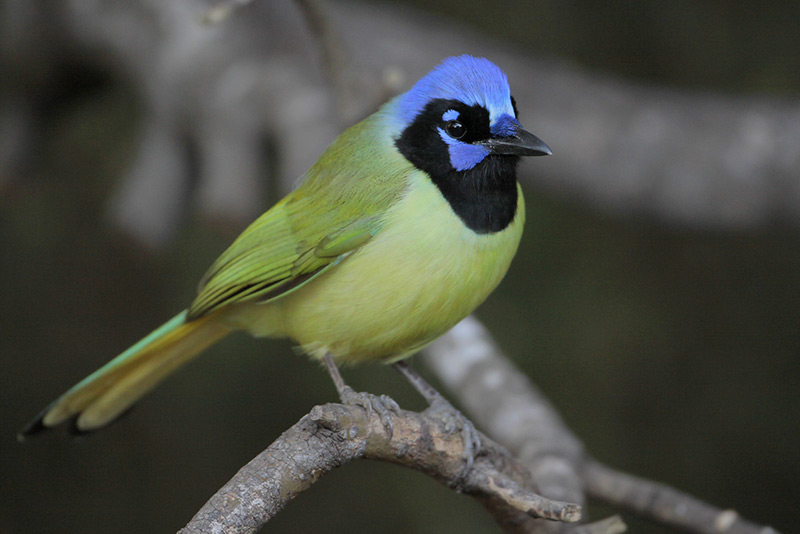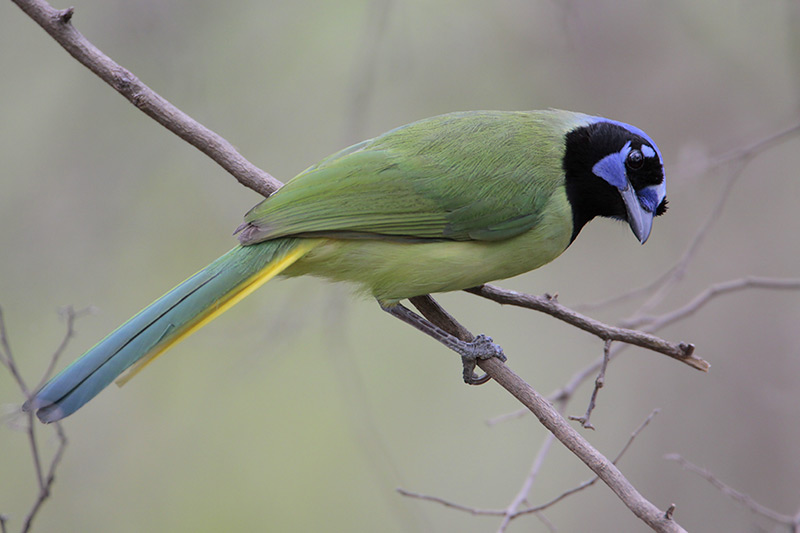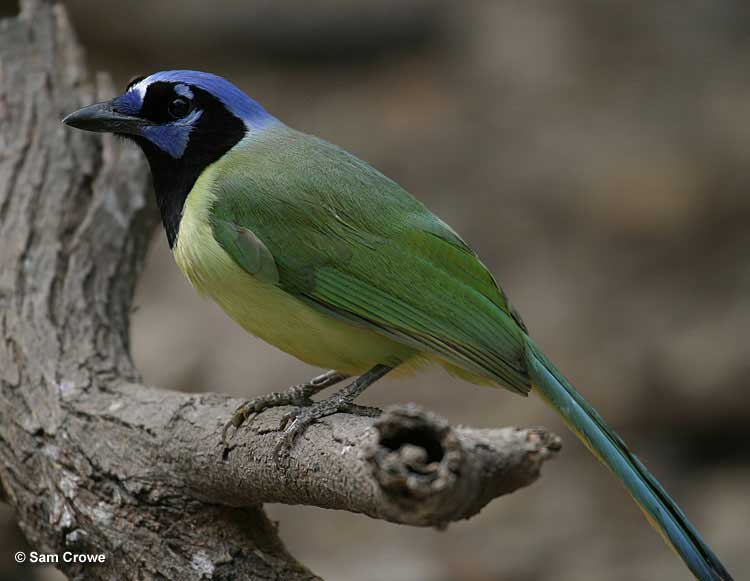The Green Jay occurs in South and Central America as well as Mexico, but barely reaches the U.S. in south Texas. Green Jays are unusual in that yearling birds often remain with their parents to help defend a breeding territory, though they do not actually help at the nest. Once the nestlings leave the nest, the yearlings are usually chased away by the parents.
Mated Green Jays are nearly inseparable during the breeding season, and often perch side by side. Little study of their lifespan has been made, but the oldest known Green Jay in the wild was over 10 years old. Green Jays frequently host Bronzed Cowbird eggs.
On this page
Description of the Green Jay
BREEDING MALE
The Green Jay has a striking appearance, with green plumage, a bluish-green tail with yellow outer tail feathers, pale greenish underparts, and a blue head with black mask and throat. Length: 11 in. Wingspan: 14 in.

Photographs © Greg Lavaty.
Female
Sexes similar.
Seasonal change in appearance
None.
Juvenile
Similar to adults but with a brownish-green head and pale yellow underparts.
Habitat
Woodlands and brushy areas.
Diet
Insects, rodents, lizards, eggs, berries, and nuts.

Behavior
Forages in trees and shrubs.
Range
Resident in south Texas and Mexico, as well as Central America.
More information:
Bent Life History
Visit the Bent Life History for extensive additional information on the Green Jay.
Fun Facts
Family groups of Green Jays defend territories most strongly during the breeding season.
Breeding pairs generally remain on the same territory for years, with minor boundary shifts.
Vocalizations
The call consists of a series of raspy notes.
Similar Species
- The Green Jay is unmistakable.
Nesting
The nest is cup of sticks lined with finer materials and placed in a dense tree or shrub.
Number: 2-6.
Color: Gray or greenish-white with darker markings.
Incubation and fledging:
– Young hatch at 17-18 days.
– Young fledge (leave the nest) in 19-22 days after hatching but remain with the adults for some time.
Bent Life History of the Green Jay
Published by the Smithsonian Institution between the 1920s and the 1950s, the Bent life history series of monographs provide an often colorful description of the birds of North America. Arthur Cleveland Bent was the lead author for the series. The Bent series is a great resource and often includes quotes from early American Ornithologists, including Audubon, Townsend, Wilson, Sutton and many others.
Bent Life History for the Green Jay – the common name and sub-species reflect the nomenclature in use at the time the description was written.
XANTHOURA YNCAS GLAUCESCENS Ridgway
This brilliantly colored jay brings to that favored region of the lower Rio Grande Valley in Texas a touch of tropical color that adds much to the many thrills one feels as he meets for the first time the many new forms of Mexican bird life to be found only in that unique region.
As I sat on a log near the edge of a stream in a dense forest along one of the resacas near Brownsville, I caught my first glimpse of a green jay, a flash of green, yellow, and blue, as it flitted through the thick underbrush and the trees above me. In spite of its brilliant colors it was surprisingly inconspicuous among the lights and shades of the thick foliage. I had just been admiring the dainty little Texas kingfisher that flew down the stream and perched on a fallen snag, had been lulled almost to sleep by the constant cooing of the many whitewinged doves, and awakened again by the loud calls of the gaudy Derby flycatcher. The curious chachalaca and the red-billed pigeon had their nests in the vicinity, and there were a host of other interesting birds all about me, but the green jay was the gem of the forest.
I am wondering how much longer this bird paradise will last, for I have read that huge tractors have been uprooting the forest trees, clearing up the chaparral, and plowing up the rich land to make room for the rapidly growing citrus orchards and other expanding agricultural interests. Thus will soon disappear the only chance we have of preserving on United States soil this unique fauna and flora; and all these interesting birds will have to retreat across the Mexican border, leaving our fauna that much poorer.
According to Baird, Brewer, and Ridgway (1874), “Colonel George A. McCall, Inspector-General of the United States Army, was the first person to collect these birds within our limits. He obtained them in the forests that border the Rio Grande on the southeastern frontier of Texas. There he found them all mated in the month of May, and he felt no doubt that they had their nests in the extensive and almost impenetrable thickets of mimosa, commonly called chaparral”
We learn more about it from the writings a number of years later of Dr. James C. Merrill (1876 and 1878) and George B. Sennett (1878 and 1879). The latter writes (1878): “It was first met with on April 2nd, in the vicinity of Brownsville; but it was not until we reached the heavier timber about Hidalgo that we saw it in full force. They were there April 17th in pairs, and busy constructing homes. They are most frequently seen during the breeding season in the densest woods and thickets, but at other times I am told they are common visitors of the camp, the ranche, and the huts in the outskirts of towns, to the annoyance of all on account of their thieving propensities”
The subspecies gku~cescens is smaller and its coloration is paler and duller than in the other four races of the species found in Mexico and Central America. Its range extends from the lower Rio Grande Valley southward into northern Tamaulipas and Nuevo Le6n.
Nesting: Most of the information we have on the nesting of the green jay comes from the two observers mentioned above. Mr. Sennett’s (1878) first nest was taken on April 28 “from a mezquite-tree standing in a dense thicket not far from the river-bank, and contained four fresh eggs. It was situated in a fork about fifteen feet from the ground, and was composed of sticks lined with fine stems, and a rather bulky affair.” He tells of a nest, found on April 30, that “was some nine feet from the ground on the outer branches of a small tree, and composed wholly of sticks and fine twigs. The sticks were so full of thorns that when they were crossed about among the lining branches more firmness was given to the nest than usual, and by cutting off the branches I could readily take it entire. ’17 he outside diameter is nine inches one way by eight the other; its depth is four inches; inside, three and a half inches wide by two inches deep”
Dr. Merrill (1876) reports a nest, taken on May 27 near Hidalgo, Texas: “It was placed on the horizontal branch of a waican-tree, about twenty-five feet from the ground, and was built of twigs and rootlets; the cavity was slight, and the entire structure so thin that the eggs could be seen through the bottom. These were three in number, and were quite fresh. * * * A second nest, found in the same vicinity May 8, was on a sapling seven feet from the ground; it closely resembled the first one, and contained four eggs, three far advanced in incubation; the fourth * * * was quite fresh”
Major Bendire (1895) says of the nests: “The nests are generally placed in dense thickets and well hidden among the branches at heights varying usually from 5 to 10 feet from the ground, and rarely in large trees. They are frequently found in retama, anacahuita, brasil, and hackberry bushes or trees. The outer nest consists usually of a slight platform of small thorny twigs and branches, sparingly lined with fine rootlets, small pieces of a wire-like vine, bits of moss, and occasionally dry grass and leaves. The Green Jay apparently does not use mud in the construction of its nest. * * * It is probable that two broods are sometimes raised in a season.~~ Eggs: Major Bendire (1895), with a large series of eggs before him, writes: “The number of eggs laid by this species is from three to five; sets of four are most often found. The prevailing ground color of these eggs is grayish white, occasionally pale greenish white or buff color. They are profusely spotted and blotched: but never heavily enough to hide the ground color: with different shades of brown, gray, and lavender; these markings are generally more abundant about the larger end of the egg. The shell is close grained, moderately strong, and shows little or no gloss. Their shape is mostly ovate, and sometimes short ovate”
The descriptions of the eggs, as given by others, are not very different. Mr. Sennett (1878) says that “the ground-color is usually light drab, tinged faintly with green, but I have one egg out of a set of four with the color dull yellowish-white. The markings are brown, sometimes distinctly spotted or speckled or streaked, and sometimes quite indistinct and clouded.” Dr. Merrill (1876) mentions one that “differed in having the markings most numerous at the smaller end.” The measurements of 70 eggs in the United States National Museum average 27.31 by 20.43 millimeters; the eggs showing the four extremes measure 30.8 by 21.8, 24.9 by 20.3, and 25.9 by 19.1 millimeters.
Plumages: Dr. Herbert Friedmann (1925) found a nest containing four young birds about four days old. “The young were still blind but the primary and secondary quills were beginning to sprout and were dull bluish in color. The top of the head and the spinal tract (both the skin and the neossoptiles) were greenish gray in color”
I have seen no very young birds, but Ridgway (1904) describes the juvenal plumage as follows: “Pileum, hindneck, and malar patch greenish blue, the forehead and palpebral spots similar but paler, and the nasal tufts darker; black of chin, throat, chest, etc., much duller than in adults; under parts of body very pale yellowish green or greenish yellow anteriorly, fading on flanks, abdomen, under tail-coverts, etc., into very pale creamy yellow; otherwise like adults”
Food: Austin Paul Smith (1910) charges the green jay with feeding on the eggs and young of various small birds, such as thrashers, orioles, sparrows, wrens, chats and mockingbirds, and that, outside of the nesting season, it feeds “mostly on seeds and insects. In winter the seeds of the Ebony (Siderocar pus) is the main reliance; also in less quantity the fruit of the Palmetto, to secure which they will travel far into the open”
Cottam and Knappen (1939) have given us the most detailed account of the food of this jay as follows:
Smith’s indictment is not confirmed by the only previous record of stomach contents with which the writers are familiar: that from Vernon Bailey’s field notes for April-May 1900, at Brownsville, Texas: ‘Stomach contained one grasshopper, beetles, small insects, and part of a kernel of corn.’ Except for the corn this food listed by Bailey is similar to that found by us in the stomach of a Green Jay collected by Dr. Francis Harper near Norias, Texas, on August 17, 1929. One per cent of the food consisted of fragments of two seeds of a bristlegrass (Setaria ? grisebachii), seed fragments of pricky-ash (Xanthoxylurn cI,sva-herculis), and undetermined plant fiber. The remainder of the food was animal in origin, including fragments of: sixteen or more stink bugs (Broth ymena ap.), 79%; several coreid bugs (Acwsthocephala sp.), 8%; finely ground indeterminable bugs (Heteroptera), trace; a short-horned grasshopper nymph (Acrididae), 1%; a field cricket nymph (Grylhts assisssilis), 1%; a hyinenopteran, trace; indeterminable insect, trace; and a fragment of a spider, 1%. Gravel formed 1% of the gross contents.
Behavior: AII jays are more or less alike in their behavior, and the green jay is no exception to the rule. It is a noisy and conspicuous bird, making itself known by its harsh notes and its gaudy plumage. As a rule it is not at all shy and has the usual supply of jay curiosity, and the collector should have no difficulty in obtaining all the specimens he needs. Dr. Merrill (1878) says that ‘it is often very tame and bold, entering tents and taking food off plates or from the kitchen whenever a good opportunity offers. Large numbers are caught by the soldiers in traps baited with corn, but the plumage is their only attraction as a cage-bird”
Austin Paul Smith (1910) says that the green jay: ranks above all its North American cousins in plumage, tho not in bearing. I have yet to find a species of crestless jay that is free of cowardly disposition and sneaky manner. It is born in them. The crested members of this group, as most of us well know, are no disciples of uprightness, but they can hide their faults, in a large degree, by a dignified appearance. Unluckily, for the Green Jay, his feathers seem to accentuate his sins. * It is another resident species, most at home in heavy growth along the river; altho from there it will often wander on foraging expeditions, even inspecting rural barnyards when hunger be pressing. The Green Jay is the worst gourmand in its family; and this failing often causes it to lose its liberty. Its plumage makes it very attractive as a cage bird, and to secure one only requires a wicker cage, set in a conspicuous place and baited with meat of some kind; fitted with a trap door worked by a string held by some hidden Homo, who possesses the instinct to pull the string at the opportune moment. Captivity does not curtail the Jay’s appetite, and they have been known to accept food immediately after being trapt. Indeed, this bird will eat all the time if fond he accessible; and the indulgent owner finds it a matter of difficulty to keep the bird alive more than a week, but such individuals as are fed with discretion, will live to make interesting, altho noisy pets. In a wild state the Green Jay is suspicious as becomes the tribe, tho as a rule it falls to a ruse quitely easily. If one be shot, the balance set up a din that can ordinarily only be stopt, either by shooting them all or decamping from the neighborhood.
DISTRIBUTION
Range: Lower Rio Grande Valley south to Guatemala; nonmigratory. The range of the green jay extends north to northern Jalisco (San SebastiAn); and southern Texas (Rio Grande, Lomita, and Brownsville). Eaat to Texas (Brownsville) ; Tamaulipas (Rio Cruz) ; Veracruz (Tampico, Jalapa, and Presidio); YucatAn (Rio Lagartos anti Chichen ItzA); Quintana Roo (Chunyaxche); British Honduras (Belize and Mantee) ; eastern Guatemala (Santa TomAs) ; and northeastern Honduras (Omoa). South to northern Honduras (Omoa, Santa Ana, and Chamelicon) ; southwestern Guatemala (Zapate, Naranjo, and Patio Bolas); and Oaxaca (Santa Efigenia, Guichcovi, and Plunia). West to western Oaxaca (Pluma); Guerrero (Rincon); and northwestern Jalisco (San Sebastian).
The range as outlined is for the entire species, which has been separated into several subspecies. One race (Xanthoura yncas Luxuosa) occupies the eastern edge of the Mexican Plateau from Veracruz and Puebla north to southern Tamaulipas and Nuevo Le6n; the Rio Grande green jay (X. y. glaucescens) is found in the lower Rio Grande Valley in Texas and south into the Mexican states of Nuevo Le6n and Tamaulipas; the Tehuantepec green jay CX. y. vivida) is found in southwestern Mexico and northwestern Guatemala; the Guatemalan green jay (X. y. guatirnalensis) occupies the country north and east from northern Honduras to the Yucat~in Peninsula; while the Jaliscan green jay (X. y. speciosa) is apparently confined to the state of Jalisco.
Egg dates: Texas: 47 records, April 2 to May 29; 25 records, April 15 to 30, indicating the height of the season.
Mexico: 2 records, April 23 and 30.


